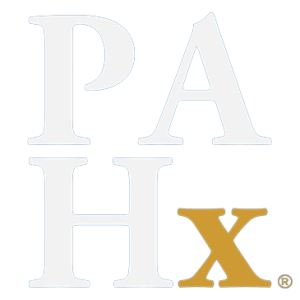Online Library
Online Articles and Books of the Society
Explore the available online articles and books created by PAHx Trustees & Historians and notable individuals and organizations involved in the PA profession.

Article Reference
Remembering the Past to Inspire the Future for Advanced Practice Professionals — The vision of Eugene A. Stead Jr., MD. Online
Bassett, P. (2020)
“Duke University: We stood there, my husband and I, gazing in absolute awe at this breathtaking building, surrounded by so many other amazing buildings, each with its unique, beautifully detailed, and refined architecture, reflecting the dedication to excellence of this great university.”
Office to study, preserve and present the history of the physician assistant profession. Perspectives on Physician Assistant Education, 11(3):185-187.
Carter, R.D. (2000)
As the physician assistant (PA) profession approaches its 35th year of existence, it is time to develop strategies, processes, and procedures to assure that its history and achievements are documented and made accessible through advanced technology to members of the profession, historians, medical sociologists, researchers, and the general public. An office for the study, preservation, and presentation of PA history is being established within the Department of Community and Family Medicine at the Duke University Medical Center for this purpose. The proposed office will provide a reliable, comprehensive, and accessible source of information about the profession’s unique origins, philosophy, structure, and interdependent relationship with the medical profession.
Physician Assistant History Feature: From the Military Corpsmen Ranks. Perspective on Physician Assistant Education, 12(2):130-132.
Carter, R.D. (2001)
An American Medical Association’s advertisement placed in the July 30, 1971 issue of Life Magazine reminds us that the plight of former medical corpsmen was used by the pioneers of our profession to gain professional and public support of Dr. Hudson’s proposal to train physician’s assistants from the ranks of “non-medical and non-nursing personnel.” Although not an easy sale, it made sense to expand the talents of these men by training them to be physician’s assistants to help meet the growing demand for health care services in the 1960s caused by a shortage of all types of medical and nursing personnel.
People v. Whittaker: The trial and its aftermath in California. Journal of Physician Assistant Education, 19(2):44-51.
Carter, R.D. (2008)
Shasta County v Whittaker, a trail held in 1966, is a seminal event that helped institutionalize the PA profession. The trial’s notoriety and adverse outcome for the defendants caught the attention of many medical societies, medical boards, and individual physicians who supported the use of informally trained assistants to help reduce physicians’ workloads. Ironically, the judgment against the defendant likely strengthened the development of the PA profession in the long run. The verdict that Roger Whittaker had “engaged in the unlicensed practice of medicine” was a strong impetus for health policy makers to develop the first round of enabling legislation that ushered PAs into American medicine.
The American Registry of Physicians’ Associates: Forerunner of the Association of Physician Assistant Programs. Perspective on Physician Assistant Education, 14(2):114-115.
Carter, R.D. & Fasser, C. (2003)
The American Registry of Physicians’ Associates was incorporated in North Carolina on May 26, 1970. The initial Board of Directors included Robert Ewer, M.D, University of Texas, Galveston, TX; D. Robert Howard, MD, Duke University and Leland Powers, MD, Bowman Gray School of Medicine. The purpose of the Registry was to encourage the training and to promote and regulate the activities of Physicians’ Associate by determining their competence through examinations and investigative studies. It would grant and issue certificates to graduates of approved educational and training programs and to others who demonstrated by examination that they possessed the background and experience to perform satisfactorily as graduates of approved programs. The registry was the forerunner of the Association of Physician Assistant Programs (APAP).
The Day NBC Came to the Hills of West Virginia. Perspective on Physician Assistant Education, 13(1):48-51.
Carter, R.D. & Holt, M. (2002)
Given the reputation and contribution of the Myers family to health care, medical, nursing and allied health education, and the little college that proved dreams can come true, it is fitting that America’s viewing public were first introduced to the PA concept as it unfolded in the hills of West Virginia. Dr. Hu and Mrs. Avanelle Myers devoted the end of their professional carriers to establishing the first baccalaureate PA program in the country at Alderson-Broaddus College in Philippi, WV. The AB PA program was featured on NBC’s Today Show on October 20, 1971.
Physician assistants: A young profession celebrates the 35th anniversary of its birth in North Carolina. NCMJ, 61(5):249-256.
Carter, R.D. & Strand, J. (2000)
The physician assistant (PA) profession began at Duke University Medical Center. It celebrates its 35th birthday on October 6, 2000. The national success of PA programs can be traced to North Carolina’s leadership in developing and using this new kind of health care professional. The North Carolina Medical Society, North Carolina Medical Board, state legislators, and state agencies like the Office of Rural Health and Area Health Education Centers (AHECs) worked together to make the program a reality.
From Vietnam to Afghanistan: The History of the Army Physician Assistant and the PA Profession. Society of Army Physician Assistants
Detro, J. F. (2012)
Major John F. Detro wrote an article detailing the ties that the physician assistant profession has with the military. He traces the history of the profession within the military.
Accommodating a New Medical Profession: The History of Physician Assistant Regulatory Legislation in North Carolina. NCMJ, 66(2):103-107
Estes, E.H. & Carter, R.D. (2005)
As pioneers of physician assistants education, the parent department of the program at Duke, the Department of Community Health Sciences, undertook the process of studying the unique problems of regulation of this new professional group, and designing model legislation to implement this regulation. The process used to design this model legislation was unique, as was the regulatory framework which resulted. Following the model’s development, it was proposed to the North Carolina General Assembly the following year. The legislative bill passed with no major opposition. This framework has served the State, the medical profession and the physician assistant profession well for over three decades, and has been the model for similar legislation in a number of other states.
Prototype PA. NCMJ, 48(11):601-603.
Gifford, J.F., Jr. (1987)
Historically, the most specific forerunner of formal physician assistant training was the family practice of Amos Johnson, M.D., and Henry Treadwell of Garland, North Carolina. The story of their professional relationship, which began in 1940 and ended with the death of Dr. Johnson in 1975, not only recalls the roots of the PA role but also raises the question of how best to conserve and expand the experience of PAs in mid-career when their original practice settings change or close.
The Creation of God Loves the Grunt: Journal of Physician Assistant Education, 18(4):59-62.
Harbert, K. (2007)
George Skypeck’s painting “God Loves the Grunt” contains thousands of names of Vietnam veterans who signed the artwork as it traveled throughout the USA in the 1980s. How the painting came about and how over 500 PAs came to sign it is a fascinating and emotional story. Prints of the painting and signatures have graced the walls of the White House and Congress and have appeared in the homes of military leaders and film and television stars. With the artist permission, the Veterans Caucus of the AAPA sale prints of the painting to generate scholarship funds for PA students who are veterans. “God Loves the Grunt” reminds us of the dedication and sacrifice of those first ex-military corpsmen who were selected to pioneer our profession. As such, the painting and artist have become an integral part of our professional history and legacy. *The official name for the Painting is “God Loves the Grunt”, though the article refers to it as “God Loves a Grunt”.
JPAE 50th Anniversary eBook
JAAPA (2017)
This special edition is a compilation of all the anniversary articles published by JAAPA and JPAE throughout 2016 and 2017.
Update: Jimmie E. Keller’s article “Presidents as Patients: PAs in the White House” co-won the best article in the Single Article category of the 2018 Folio’s Eddie Awards for Editorial Excellence!
Merger of the Academy and College. Journal Physician Assistant Education, 17(4):57-58.
Joseph, B. & Carter, R.D. (2007)
The American Academy of Physician Assistants was not always the only organization representing practicing PAs. In this article, the authors explore the pressures that forced the early PA professional organizations to consider a merger and how the Academy was able to reshape itself without giving up its growing academic power base and influence. Will the Academy be able to maintain its central role as the organization representing clinical PAs as its membership becomes even more diversified? Only time will tell.
Physician Assistant: A Respected and Unique Brand. PA Professional, 4(1): 26-27.
Piemme, T.E. & Sadler, A.M., Jr. (2012)
Through the years of the existence of the physician assistant profession, there have been periodic arguments for a change in the title of the PA practitioner to physician “associate,” rather than “assistant.” While the case to be made is not entirely unreasonable, it has been met with strong opposition by the medical profession, which considers the word, “associate,” to refer exclusively to fellow physician colleagues. Meanwhile, with the passage of time, the term, “physician assistant,” has become imbedded in thousands of corporate documents; state and federal laws, regulations, and agencies; and departments within academic institutions. The cost of a name-change would be prohibitive, even if it were to be universally recognized. Moreover, in the half century since its founding, the concept has become a “brand” to the public — instantly recognizable, and accepted with respect and admiration. It should be regarded with pride, and embraced by all who practice this noble profession.
The Vagabond Apostrophe. PA Professional, 4(5), 52-53.
Piemme, T.E. & Sadler, Jr., A.M. (2012)
From the outset, Eugene Stead, Jr. and his colleagues at Duke University referred to their program and its graduates, using the term, “physician’s assistants.” Grammarians within the councils of the AMA, however, considered these new practitioners in the aggregate to be “physicians’ assistants.” Countless hours of debate among physicians and educators appeared to have no influence on the placement of the apostrophe, however. Evading the issue, early minutes of what was to become the AAPA, and early publications of the Association of PA Programs deleted both the “s” and its accompanying apostrophe altogether. A free-for-all ensued among the three options to the extent that one can find the placement of the apostrophe used differently within a single document, and between articles in the same issue of a refereed journal. It wasn’t until the early 1980s that all of the major governing organizations amended their founding documents to conform with a professional consensus that no possessive punctuation was appropriate. All hail the “physician assistant.”
The black physician’s assistant: problems and prospects. Academic Medicine, 53(8), 661-6.
Schneller, E.S. & Weiner, T.S. (1978)
An article that shows a historic perspective on the recruitment of African-Americans to the Physician Assistant profession in the late 1970s.
The roots of the AAPA. Journal of the American Academy of Physician Assistants, 5(9), 671-671.
Stanhope, W. D. (1992)
Because of the criticisms directed at their chosen profession and the absence of educational criteria essential for greater employment opportunities within the health care system, the first students and graduates of PA programs banded together under the umbrella of the American Academy of Physician Assistants (AAPA). Soon after the AAPA’s incorporation in 1968, its leaders found themselves embroiled in discussions dealing with occupational nomenclature, practitioner education, and competency assurance, all of which resulted from involvement in the processes of program accreditation and graduate certification. During these discussions among themselves and with their advisors, the leaders set the stage for an organizational infrastructure that would encompass a House of Delegates, constituent chapters, committees, strategic planning, and liaison activities with other organizations. The subsequent establishment of a national office with an employed staff allowed for a more proactive stance on issues, particularly Medicare reimbursement. Long-range management also provided the financial reserves needed in future years to construct a lasting monument to the profession, the national AAPA office in Alexandria, Virginia.
The Practicante: Puerto Rico – Physician Assistant Prototype. Journal of Physician Assistant Education, 17(2):60-62.
Strand, J. (2006)
Feldshers, barefoot doctors and frontier nurses are often cited as examples of prototypical physician assistants. But there is another, not previously mentioned in the literature – the practicante. Exported from Spain to Puerto Rico, the practicante was used to extend physician health care services in the commonwealth from the mid-1800s into the 1940s. It is ironic that the last place in the US and its territories to enact enabling legislation for PAs was the first place in the Western hemisphere to legitimize and use a PA-like provider.
Cost Effectiveness of Physician’s Assistants
US Dept. of Health, Education, and Welfare (1975)
Because of the criticisms directed at their chosen profession and the absence of educational criteria essential for greater employment opportunities within the health care system, the first students and graduates of PA programs banded together under the umbrella of the American Academy of Physician Assistants (AAPA). Soon after the AAPA’s incorporation in 1968, its leaders found themselves embroiled in discussions dealing with occupational nomenclature, practitioner education, and competency assurance, all of which resulted from involvement in the processes of program accreditation and graduate certification. During these discussions among themselves and with their advisors, the leaders set the stage for an organizational infrastructure that would encompass a House of Delegates, constituent chapters, committees, strategic planning, and liaison activities with other organizations. The subsequent establishment of a national office with an employed staff allowed for a more proactive stance on issues, particularly Medicare reimbursement. Long-range management also provided the financial reserves needed in future years to construct a lasting monument to the profession, the national AAPA office in Alexandria, Virginia.
Physicians’ assistants. Archives of Ophthalmology, 86(4): 367-367.
Worthen, D.M. (1971)
An Editorial by an optometrist arguing against the “Duffy Amendment”, which several states had adopted in the early 70s. The Amendment stated that physician assistants were free to practice as long as were not working in the ophthalmology field.
Book Reference
American Academy of Physician Assistants. The Future of Health Care Challenges and Choices
Virginia, Arlington: American Academy of Physician Assistants, 1985
A collection of research papers that were presented at the October 1984 symposium: The Future of Health Care Challenges and Choices. Authors include John Hogness, Kenneth Moritsugu, Bertram Brown, Harvey Sapolsky, Irving Bluestone, Milton Terris, Carolyne Davis, Thomas Herrmann, Robert Katz, Seymour Perry, Henry Aaron, Henry Perry, and James Cawley.
PA History Society Staff. Physician Assistant History Society Celebrating 20 Years: 2002-2022
Johns Creek, GA: PA History Society, 2022
The PA History Society was established January 17th, 2002. This manuscript details the Society’s history: how it came about, what it has accomplished in its 20 years, and what its plans are for the future.
Sadler, AM, Jr., Sadler, BL, Bliss, AA. The Physician’s Assistant: Today and Tomorrow. (2nd Ed.)
Cambridge, MA: Ballinger Publishing Company, 1975
The first book written about Physician Assistants.


